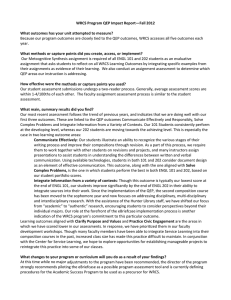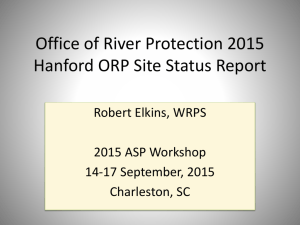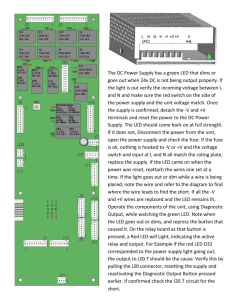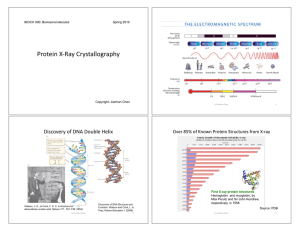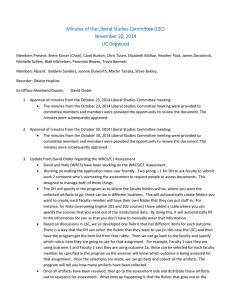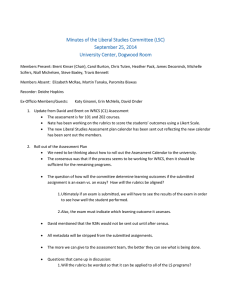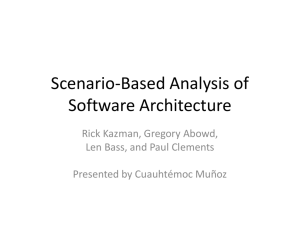vii TABLE OF CONTENTS CHAPTER
advertisement
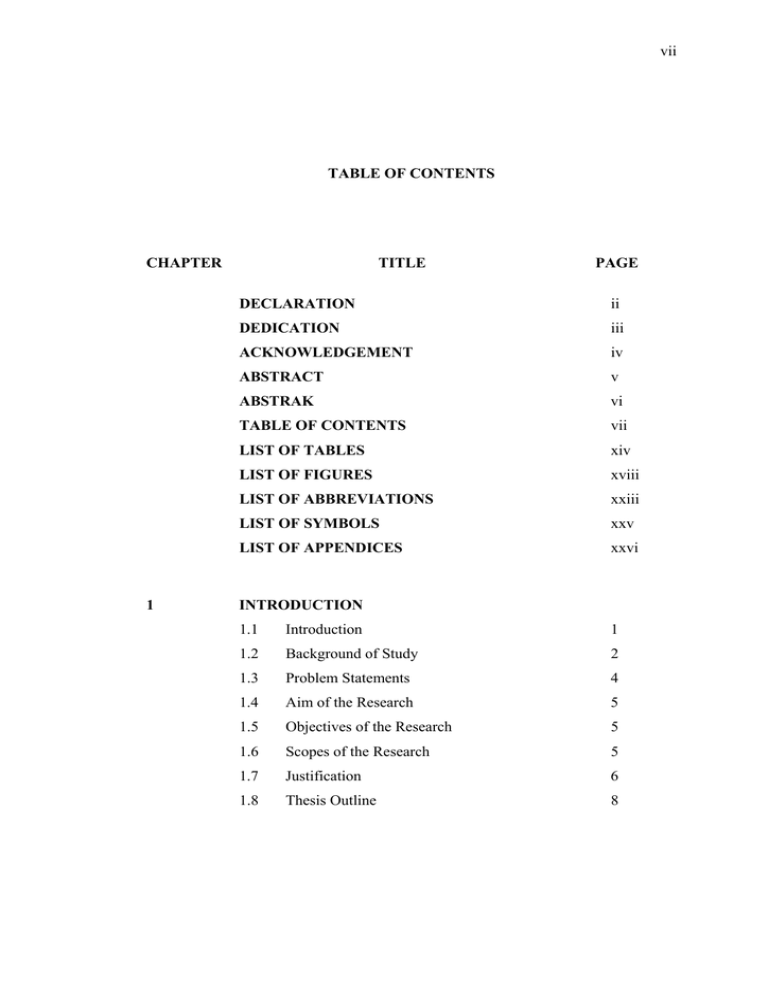
vii TABLE OF CONTENTS CHAPTER 1 TITLE PAGE DECLARATION ii DEDICATION iii ACKNOWLEDGEMENT iv ABSTRACT v ABSTRAK vi TABLE OF CONTENTS vii LIST OF TABLES xiv LIST OF FIGURES xviii LIST OF ABBREVIATIONS xxiii LIST OF SYMBOLS xxv LIST OF APPENDICES xxvi INTRODUCTION 1.1 Introduction 1 1.2 Background of Study 2 1.3 Problem Statements 4 1.4 Aim of the Research 5 1.5 Objectives of the Research 5 1.6 Scopes of the Research 5 1.7 Justification 6 1.8 Thesis Outline 8 viii 2 REVIEW OF SPEECH RECOGNITION AND NEURAL NETWORK 2.1 Fundamental of Speech Recognition 10 2.2 Linear Predictive Coding (LPC) 11 2.3 Speech Recognition Approaches 16 2.3.1 Dynamic Time Warping (DTW) 16 2.3.2 Hidden Markov Model (HMM) 17 2.3.3 Artificial Neural Network (ANN) 18 2.4 2.5 2.6 2.7 Comparison between Speech Recognition Approaches 20 Review of Artificial Neural Networks 21 2.5.1 Processing Units 21 2.5.2 Connections 22 2.5.3 Computation 22 2.5.4 Training 23 Types of Neural Networks 24 2.6.1 24 Supervised Learning 2.6.2 Semi-Supervised Learning 25 2.6.3 25 Unsupervised Learning 2.6.4 Hybrid Networks 26 Related Research 27 2.7.1 Phoneme/Subword Classification 27 2.7.2 Word Classification 29 2.7.3 Classification Using Hybrid Neural Network Approach 2.8 3 Summary 31 32 SPEECH DATASET DESIGN 3.1 Human Speech Production Mechanism 33 3.2 Malay Morphology 35 3.2.1 35 Primary Word 3.2.2 Derivative Word 38 3.2.3 39 Compound Word ix 3.2.4 3.3 Malay Speech Dataset Design 3.3.1 3.3.2 3.4 4 Reduplicative Word 39 39 Selection of Malay Speech Target Sounds 40 Acquisition of Malay Speech Dataset 44 Summary 46 FEATURE EXTRACTION AND CLASSIFICATION ALGORITHM 4.1 4.2 4.3 4.4 The Architecture of Speech Recognition System 47 Feature Extractor (FE) 48 4.2.1 Speech Sampling 49 4.2.2 Frame Blocking 50 4.2.3 Pre-emphasis 51 4.2.4 Windowing 51 4.2.5 Autocorrelation Analysis 52 4.2.6 LPC Analysis 52 4.2.7 Cepstrum Analysis 53 4.2.8 Endpoint Detection 54 4.2.9 Parameter Weighting 55 Self-Organizing Map (SOM) 55 4.3.1 SOM Architecture 57 4.3.2 Learning Algorithm 58 4.4.3 Dimensionality Reduction 63 Multilayer Perceptron (MLP) 65 4.4.1 MLP Architecture 65 4.4.2 66 Activation Function 4.4.3 Error-Backpropagation 67 4.4.4 Improving Error-Backpropagation 69 4.4.5 Implementation of ErrorBackpropagation 4.5 Summary 73 74 x 5 SYSTEM DESIGN AND IMPLEMENTATION 5.1 Introduction 75 5.2 Implementation of Speech Processing 76 5.2.1 76 Feature Extraction using LPC 5.2.2 Endpoint Detection 80 5.3 Implementation of Self-Organizing Map 91 5.4 Implementation of Multilayer Perceptron 97 5.4.1 MLP Architecture for Digit Recognition 5.4.2 5.4.3 5.5 6 97 MLP Architecture for Word Recognition 98 Implementation of MLP 99 Experiment Setup 107 RESULTS AND DISCUSSION 6.1 Introduction 109 6.2 Testing of Digit Recognition 111 6.2.1 Testing Results for Conventional System 111 6.2.1.1 Experiment 1: Optimal Cepstral Order (CO) 111 6.2.1.2 Experiment 2: Optimal Hidden Node Number (HNN) 112 6.2.1.3 Experiment 3: Optimal Learning Rate (LR) 6.2.2 114 Results for Proposed System Testing 115 6.2.2.1 Experiment 1: Optimal Cepstral Order (CO) 115 6.2.2.2 Experiment 2: Optimal Dimension of SOM (DSOM) 116 6.2.2.3 Experiment 3: Optimal Hidden Node Number (HNN) 117 xi 6.2.2.4 Experiment 4: Optimal Learning Rate (LR) 6.2.3 119 Discussion for Digit Recognition Testing 120 6.2.3.1 Comparison of Performance for DRCS and DRPS (CO) 120 6.2.3.2 Comparison of Performance for DRCS and DRPS (HNN) 121 6.2.3.3 Comparison of Performance for DRCS and DRPS (LR) 123 6.2.3.4 Discussion on Performance of DRPS according to DSOM 124 6.2.3.5 Summary for Digit Recognition Testing 6.3 Testing of Word Recognition 6.3.1 125 126 Results for Conventional System Testing (Syllable Classification) 126 6.3.1.1 Experiment 1: Optimal Cepstral Order (CO) 126 6.3.1.2 Experiment 2: Optimal Hidden Node Number (HNN) 127 6.3.1.3 Experiment 3: Optimal Learning Rate (LR) 6.3.2 128 Results for Conventional System Testing (Word Classification) 130 6.3.2.1 Experiment 1: Optimal Cepstral Order (CO) 130 6.3.2.2 Experiment 2: Optimal Hidden Node Number (HNN) 131 6.3.2.3 Experiment 3: Optimal Learning Rate (LR) 6.3.3 132 Results for Proposed System Testing (Syllable Classification) 133 xii 6.3.3.1 Experiment 1: Optimal Cepstral Order (CO) 133 6.3.3.2 Experiment 2: Optimal Dimension of SOM (DSOM) 135 6.3.3.3 Experiment 3: Optimal Hidden Node Number (HNN) 136 6.3.3.4 Experiment 4: Optimal Learning Rate (LR) 6.3.4 137 Results for Proposed System Testing (Word Classification) 138 6.3.4.1 Experiment 1: Optimal Cepstral Order (CO) 138 6.3.4.2 Experiment 2: Optimal Dimension of SOM (DSOM) 140 6.3.4.3 Experiment 3: Optimal Hidden Node Number (HNN) 141 6.3.4.4 Experiment 4: Optimal Learning Rate (LR) 6.3.5 142 Discussion for Word Recognition Testing 143 6.3.5.1 Comparison of Performance for WRCS and WRPS according to CO 143 6.3.5.2 Comparison of Performance for WRCS and WRPS according to HNN 146 6.3.5.3 Comparison of Performance for WRCS and WRPS according to LR 149 6.3.5.4 Comparison of Performance of WRPS according to DSOM 152 xiii 6.3.5.5 Comparison of Performance for WRCS and WRPS according to Type of Classification 155 6.3.5.6 Summary of Discussion for Word Recognition 6.4 7 Summary 156 157 CONCLUSION AND SUGGESTION 7.1 Conclusion 158 7.2 Directions for Future Research 159 REFERENCES 162 PUBLICATIONS 170 Appendices A – V 171 - 192 xiv LIST OF TABLES TABLE NO. 1.1 TITLE PAGE Comparison of different speech recognition systems. 7 The comparison between different speech recognition approaches. 20 The performance comparison between different speech recognition approaches. 20 3.1 Structure of words with one syllable. 36 3.2 Structure of words with two syllables. 37 3.3 Structure of words with three syllables or more. 38 3.4 15 selected syllables in order to form two-syllable words as target sounds. 41 Two-syllable Malay words combined using 15 selected syllables. 42 30 selected Malay two-syllable words as the speech target sounds. 43 10 selected digit words as the speech target sounds for digit recognition. 44 3.8 Specification of dataset for word recognition 45 3.9 Specification of dataset for digit recognition 45 5.1 The setting of the target values for MLP in digit recognition. 98 The setting of the target values for MLP (syllable classification). 100 2.1 2.2 3.5 3.6 3.7 5.2 xv 5.3 The setting of the target values for MLP (word classification). 101 Recognition accuracy for different CO for Experiment 1 (DRCS) 111 Recognition accuracy for different HNN for Experiment 2 (DRCS) 113 Recognition accuracy for different LR for Experiment 3 (DRCS) 114 Recognition accuracy for different CO for Experiment 1 (DRPS) 115 Recognition accuracy for different DSOM for Experiment 2 (DRPS) 116 Recognition accuracy for different HNN for Experiment 3 (DRPS) 118 Recognition accuracy for different LR for Experiment 4 (DRPS) 119 Comparison of performance for DRCS and DRPS according to CO 120 Comparison of performance for DRCS and DRPS according to HNN 122 Comparison of performance for DRCS and DRPS according to LR 123 6.11 The optimal parameters and the architecture for DRPS 125 6.12 Recognition accuracy for different CO for Experiment 1 (WRCS(S)) 126 Recognition accuracy for different HNN for Experiment 2 (DRCS) 127 Recognition accuracy for different LR for Experiment 3 (WRCS(S)) 129 Recognition accuracy for different CO for Experiment 1 (WRCS(W)) 130 Recognition accuracy for different HNN for Experiment 2 (WRCS(W)) 131 6.1 6.2 6.3 6.4 6.5 6.6 6.7 6.8 6.9 6.10 6.13 6.14 6.15 6.16 xvi 6.17 6.18 6.19 6.20 6.21 6.22 6.23 6.24 6.25 6.26 6.27 6.28 6.29 6.30 6.31 6.32 6.33 Recognition accuracy for different LR for Experiment 3 (WRCS(W)) 132 Recognition accuracy for different CO for Experiment 1 (WRPS(S)) 134 Recognition accuracy for different DSOM for Experiment 2 (WRPS(S)) 135 Recognition accuracy for different HNN for Experiment 3 (WRPS(S)) 136 Recognition accuracy for different LR for Experiment 4 (WRPS(S)) 137 Recognition accuracy for different CO for Experiment 1 (WRPS(W)) 139 Recognition accuracy for different DSOM for Experiment 2 (WRPS(W)) 140 Recognition accuracy for different HNN for Experiment 3 (WRPS(W)) 141 Recognition accuracy for different LR for Experiment 4 (WRPS(W)) 142 Comparison of performance for WRCS(S) and WRPS(S) according to CO. 144 Comparison of performance for WRCS(W) and WRPS(W) according to CO. 145 Comparison of performance for WRCS(S) and WRPS(S) according to HNN. 146 Comparison of performance for WRCS(W) and WRPS(W) according to HNN. 147 Comparison of performance for WRCS(S) and WRPS(S) according to LR. 149 Comparison of performance for WRCS(W) and WRPS(W) according to LR. 150 Comparison of performance for WRPS according to DSOM. 152 Results of testing for WRCS and WRPS according to type of classification 155 xvii 6.34 The optimal parameters and the architecture for WRPS(S). 156 xviii LIST OF FIGURES FIGURE NO. 1.1 TITLE PAGE Feature map with neurons (circles) which is labeled with the symbols of the phonemes to which they “learned” to give the best responses. 3 The sequence of the responses obtained from the trained feature map when the Finnish word humppila was uttered. 3 2.1 Basic model of speech recognition system. 11 2.2 The current speech sample is predicted as a linear combination of past p samples. (n = total number of speech sample). 12 2.3 Dynamic Time Warping (DTW) 17 2.4 A basic architecture of Multilayer Perceptron (MLP) 19 2.5 A basic neuron processing unit 22 2.6 Neural network topologies: (a) Unstructured, (b) Layered, (c) Recurrent and (d) Modular 23 Perceptrons: (a) Single-layer Perceptron (b) Multilayer Perceptron 25 Decision regions formed by a 2-layer Perceptron using backpropagation training and vowel formant data. 28 3.1 The vocal tract 34 3.2 Structure of one-syllable word “Ya” and “Stor”. 36 3.3 Structure of two-syllable word “Guru” and “Jemput”. 37 4.1 Proposed speech recognition model 47 1.2 2.7 2.8 xix 4.2 Feature Extractor (FE) schematic diagram 48 4.3 Figure 4.3: Speech signal for the word kosong01.wav sampled at 16 kHz with a precision of 16 bits. 49 Blocking of speech waveform into overlapping frames with N analysis frame length and M shifting length. 50 4.5 Cepstral coefficient of BU.cep 54 4.6 SOM transforms feature vectors generated by speech processing into binary matrix which performs dimensionality reduction. 56 4.7 The 2-D SOM architecture 57 4.8 Flow chart of SOM learning algorithm 61 4.9 Trained feature map after 1,250,000 iterations. 62 4.10 Dimensionality reduction performed by SOM. 63 4.11(a) The 12 x 12 mapping of binary matrix of /bu/ syllable. 64 4.11(b) Binary matrix of /bu/ which is fed as input for MLP. 64 4.12 A three-layer Multilayer Perceptron 66 4.13 The determination of hidden node number using Geometric Pyramid Rule (GPR). 71 4.14 Flow chart of error-backpropagation algorithm 73 5.1 The implementation of speech recognition system 75 5.2(a) The detected boundaries of sembilan04.wav using rms energy in Level 1 of Initial endpoint detection 90 The detected boundaries of sembilan04.wav using zero crossing rate in Level 2 of Initial endpoint detection 90 The actual boundaries of sembilan04.wav using Euclidean distance of cepstrum in Level 3 of Actual endpoint detection 90 5.3 The architecture of Self-Organizing Map (SOM) 91 5.4 MLP with 10 output. The 10 output nodes correspond to 10 Malay digit words respectively. 97 4.4 5.2(b) 5.2(c) xx 5.5 MLP with 15 output nodes. The 15 output nodes correspond to 15 Malay syllables respectively. 99 MLP with 30 output nodes. The 30 output nodes correspond to 30 Malay two-syllable words respectively. 99 System architecture for conventional model (singlenetwork) 108 System architecture for proposed model (hybrid network) 108 5.9 Training and testing of the digit recognition system 109 5.10 Training and testing of the word recognition system 109 6.1 Presentation and discussion of the results of the tests in table and graph form in stages. 110 Recognition accuracy for different CO for Experiment 1 (DRCS) 112 Recognition accuracy for different HNN for Experiment 2 (DRCS) 113 Recognition accuracy for different LR for Experiment 3 (DRCS) 114 Recognition accuracy for different CO for Experiment 1 (DRPS) 116 Recognition accuracy for different DSOM for Experiment 2 (DRPS) 117 Recognition accuracy for different HNN for Experiment 3 (DRPS) 118 Recognition accuracy for different LR for Experiment 4 (DRPS) 119 Analysis of comparison of performance for DRCS and DRPS according to CO. 121 Analysis of comparison of performance for DRCS and DRPS according to HNN. 122 Analysis of comparison of performance for DRCS and DRPS according to LR. 124 5.6 5.7 5.8 6.2 6.3 6.4 6.5 6.6 6.7 6.8 6.9 6.10 6.11 xxi 6.12 6.13 6.14 6.15 6.16 6.17 6.18 6.19 6.20 6.21 6.22 6.23 6.24 6.25 6.26 6.27 6.28 Recognition accuracy for different CO for Experiment 1 (WRCS(S)) 127 Recognition accuracy for different HNN for Experiment 2 (WRCS(S)) 128 Recognition accuracy for different LR for Experiment 3 (WRCS(S)) 129 Recognition accuracy for different CO for Experiment 1 (WRCS(W)) 130 Recognition accuracy for different HNN for Experiment 2 (WRCS(W)) 132 Recognition accuracy for different LR for Experiment 3 (WRCS(W)) 133 Recognition accuracy for different CO for Experiment 1 (WRPS(S)) 134 Recognition accuracy for different DSOM for Experiment 2 (WRPS(S)) 135 Recognition accuracy for different HNN for Experiment 3 (WRPS(S)) 137 Recognition accuracy for different LR for Experiment 4 (WRPS(S)) 138 Recognition accuracy for different CO for Experiment 1 (WRPS(W)) 139 Recognition accuracy for different DSOM for Experiment 2 (WRPS(W)) 140 Recognition accuracy for different HNN for Experiment 3 (WRPS(W)) 142 Recognition accuracy for different LR for Experiment 4 (WRPS(W)) 143 Comparison of performance for WRCS(S) and WRPS(S) according to CO. 144 Comparison of performance for WRCS(W) and WRPS(W) according to CO. 145 Comparison of performance for WRCS(S) and WRPS(S) according to HNN. 147 xxii 6.29 6.30 6.31 6.32 6.33(a) 6.33(b) 6.34 Comparison of performance for WRCS(W) and WRPS(W) according to HNN. 148 Comparison of performance for WRCS(S) and WRPS(S) according to LR. 150 Comparison of performance for WRCS(W) and WRPS(W) according to LR. 151 Comparison of performance for WRPS according to DSOM. 153 Matrix mapping of “buku” word where the arrows show the direction of the sequence of phonemes. 154 Matrix mapping of “kubu” word where the arrows show the direction of the sequence of phonemes. 154 Analysis of comparison of performance for WRCS and WRPS according to syllable classification and word classification. 155 xxiii LIST OF ABBREVIATIONS AI - Artificial Intelligence ANN - Artificial Neural Network BMU - Best Matching Unit BP - Back-Propagation CO - Cepstral Order CS - Conventional System DR - Digit Recognition DRCS - Digit Recognition Conventional System DRPS - Digit Recognition Proposed System DSOM - Dimension of Self-Organizing Map DTW - Dynamic Time Warping FE - Feature Extractor GPR - Geometric Pyramid Rule HMM - Hidden Markov Model HNN - Hidden Node Number KSOM - Kohonen Self-Organization Network LP - Linear Prediction LPC - Linear Predictive Coding LR - Linear Rate LVQ - Learning Vector Quantization MLP - Multilayer Perceptron PARCOR - Partial-Correlation PC - Personal Computer PS - Proposed System SAMSOM - Structure Adaptive Multilayer Self-Organizing Map SLP - Single-layer Perceptron SOM - Self-Organizing Map xxiv TDNN - Time-Delay Neural Network VQ - Vector Quantization WPF - Winning Probability Function WR - Word Recognition WRCS - Word Recognition Conventional System WRCS(S) - Word Recognition Conventional System using Syllable Classification WRCS(W) - Word Recognition Conventional System using Word Classification WRPS - Word Recognition Proposed System WRPS(S) - Word Recognition Proposed System using Syllable Classification WRPS(W) - Word Recognition Proposed System using Word Classification xxv LIST OF SYMBOLS s - Speech sample ŝ - Predicted speech sample a - Predicted coefficient e - Prediction error E - Mean squared error (LPC) E - Energy power (Endpoint detection) Z - Zero-crossing T - Threshold (Endpoint detection) D - Weighted Euclidean distance R - Autocorrelation function w - Hamming window p - The order of the LPC analysis k - PARCOR coefficients c - Cepstral coefficients X - Input nodes Y - Output nodes H - Hidden nodes M - Weights B - Bias σ - Width of lattice (SOM) λ - Time constant (SOM) α - Learning rate (SOM) Θ - The amount of influence a node's distance from the BMU (SOM) η - Learning rate (MLP) δ - Error information term xxvi LIST OF APPENDICES APPENDIX A B C D E F G H I J K L TITLE PAGE Specification of test on optimal Cepstral Order for DRCS 171 Specification of test on optimal Hidden Node Number for DRCS 172 Specification of test on optimal Learning Rate for DRCS 173 Specification of test on optimal Cepstral Order for DRPS 174 Specification of test on optimal Dimension of SOM for DRPS 175 Specification of test on optimal Hidden Node Number for DRPS 176 Specification of test on optimal Learning Rate for DRPS 177 Specification of test on optimal Cepstral Order for WRCS(S) 178 Specification of test on optimal Hidden Node Number for WRCS(S) 179 Specification of test on optimal Learning Rate for WRCS(S) 180 Specification of test on optimal Cepstral Order for WRCS(W) 181 Specification of test on optimal Hidden Node Number for WRCS(W) 182 xxvii M N O P Q R S T U V Specification of test on optimal Learning Rate for WRCS(W) 183 Specification of test on optimal Cepstral Order for WRPS(S) 184 Specification of test on optimal Dimension of SOM for WRPS(S) 185 Specification of test on optimal Hidden Node Number for WRPS(S) 186 Specification of test on optimal Learning Rate for WRPS(S) 187 Specification of test on optimal Cepstral Order for WRPS(W) 188 Specification of test on optimal Dimension of SOM for WRPS(W) 189 Specification of test on optimal Hidden Node Number for WRPS(W) 190 Specification of test on optimal Learning Rate for WRPS(W) 191 Convergences file (dua12.cep) which shows the rms error in each epoch. 192
